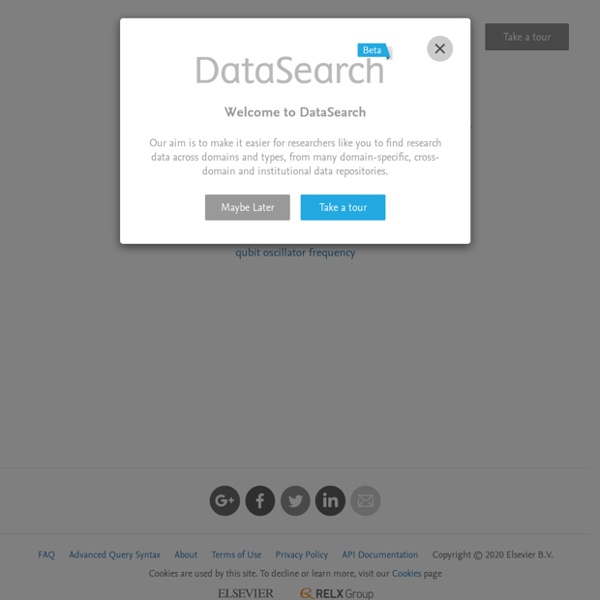



https://datasearch.elsevier.com/#/
Related: Academic Search Engines • StatisticsAcademic Search Engines Additional Resources Information and Tips A note on Authoritative Regardless of where you find information, it is important to evaluate the source of it, especially if you are using it for decision-making or in an educational setting. The R Trader » Blog Archive » BERT: a newcomer in the R Excel connection A few months ago a reader point me out this new way of connecting R and Excel. I don’t know for how long this has been around, but I never came across it and I’ve never seen any blog post or article about it. So I decided to write a post as the tool is really worth it and before anyone asks, I’m not related to the company in any way. BERT stands for Basic Excel R Toolkit. It’s free (licensed under the GPL v2) and it has been developed by Structured Data LLC.
Search Engines:Research Aid Databases From Topical Search Wiki Academic Ranking Journals characteristics SHERPA Databases RoMEO – A database of publisher's policies regarding the self- archiving of journal articles on the web and in Open Access repositories. JULIET – A database of funders archiving mandates and guidelines. [2]CofactorJournalGuideGenamics JournalSeek – A catalog of research journals including journal description, abbreviation, homepage link, subject category and ISSN. Reference works Scholars social networks CrossRef – An authoritative catalog of primary research publications. JournalTOCs – A catalog of academic journals tables of contents (TOCs) RSS feeds. Related Pages
Downloadable Sample SPSS Data Files Downloadable Sample SPSS Data Files Data QualityEnsure that required fields contain data.Ensure that the required homicide (09A, 09B, 09C) offense segment data fields are complete.Ensure that the required homicide (09A, 09B, 09C) victim segment data fields are complete.Ensure that offenses coded as occurring at midnight are correctEnsure that victim variables are reported where required and are correct when reported but not required. Standardizing the Display of IBR Data: An Examination of NIBRS ElementsTime of Juvenile Firearm ViolenceTime of Day of Personal Robberies by Type of LocationIncidents on School Property by HourTemporal Distribution of Sexual Assault Within Victim Age CategoriesLocation of Juvenile and Adult Property Crime VictimizationsRobberies by LocationFrequency Distribution for Victim-Offender Relationship by Offender and Older Age Groups and Location
Guide to academic search This guide was created by the curator of the JURN search-engine. Below is a short guide to various free search-engines and tools. Specifically, to those tools likely to lead to open material useful for UK students and researchers in the arts and humanities. Last updated: 17th September 2018. Last checked for link-rot: November 2017. Introduction to Principal Component Analysis (PCA) - Laura Diane Hamilton Principal Component Analysis (PCA) is a dimensionality-reduction technique that is often used to transform a high-dimensional dataset into a smaller-dimensional subspace prior to running a machine learning algorithm on the data. When should you use PCA? It is often helpful to use a dimensionality-reduction technique such as PCA prior to performing machine learning because: Reducing the dimensionality of the dataset reduces the size of the space on which k-nearest-neighbors (kNN) must calculate distance, which improve the performance of kNN. Reducing the dimensionality of the dataset reduces the number of degrees of freedom of the hypothesis, which reduces the risk of overfitting. Most algorithms will run significantly faster if they have fewer dimensions they need to look at.
Top Thesis & Dissertation References on the Web: OnlinePhDprogram.org A Master’s Thesis or Doctoral Dissertation is the capstone of many graduate programs. It requires a monumental amount of effort to put together the original research, citations, and sheer writing time to finish. Many students cruise through their master’s and PhD coursework without breaking a sweat, only to be stonewalled when it comes time to write a long, in-depth dissertation that contributes original material to the student’s chosen field. Bluntly, finishing a thesis or dissertation is hard, and nobody can do it alone. Do Faster Data Manipulation using These 7 R Packages Introduction Data Manipulation is an inevitable phase of predictive modeling. A robust predictive model can’t be just be built using machine learning algorithms. But, with an approach to understand the business problem, the underlying data, performing required data manipulations and then extracting business insights. Among these several phases of model building, most of the time is usually spent in understanding underlying data and performing required manipulations.
Cogent OA Is Impact Factor here to stay? The digital age provides a platform for research and researchers as never before. Open access publishing facilitates global readership and a wide exposure for your work. With our partnership with Altmetric.com, we bring you enhanced article-level metrics so you can track who reads, shares and cites your work, and from where.